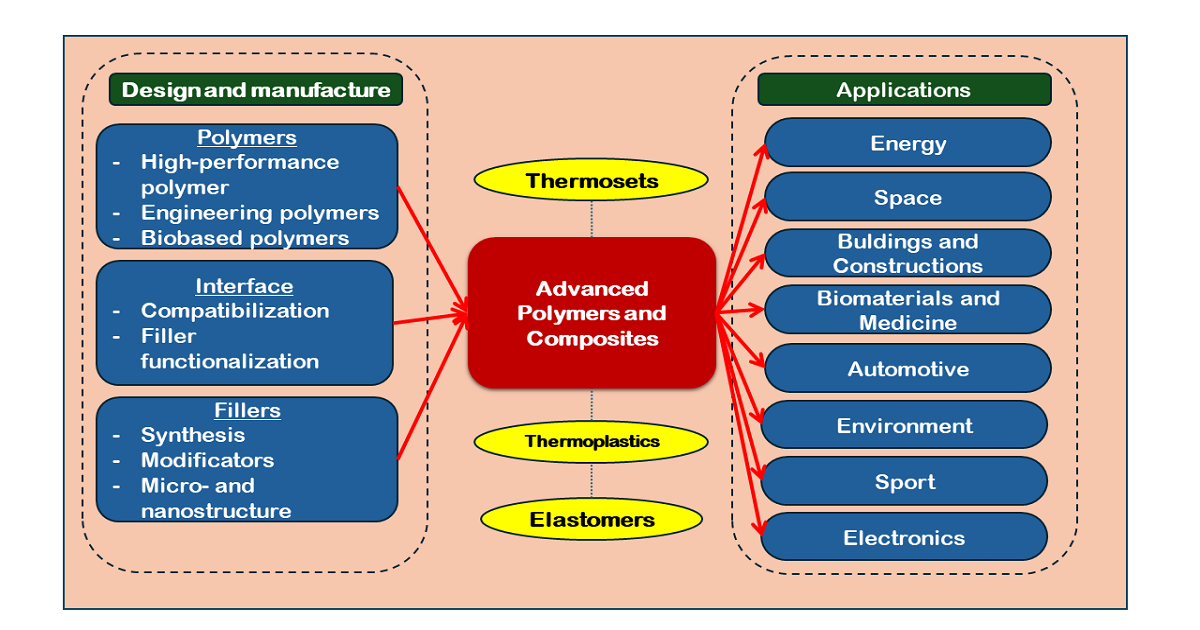- 3.2Impact Factor
- 6.4CiteScore
- 16 daysTime to First Decision
Advanced Polymers and Composites for Multifunctional Applications
This special issue belongs to the section “Polymeric Materials“.
Special Issue Information
Dear Colleagues,
Advanced polymers and composites are an interesting and rapidly growing class of novel multifunctional materials with desirable properties, intended for specialized applications. They are considered promising materials for multifunctional applications, including biomedical, aerospace, automotive, electronics, energy, construction, and buildings, as well as in the chemical industry.
The structure and properties of advanced polymers and their composites strongly depend not only on the type of polymer matrix; its average molar mass, dispersity, and structure; and the architecture of the polymer chains, but also on the filler’s type and content, shape, size, and compatibility with the polymer matrix. Both fillers and nanofillers can strongly influence thermal and mechanical properties, flame retardancy, and thermal and electrical conductivity. However, further functionalization and modifications can provide new properties and allow for the development of multifunctional systems for advanced applications.
This Special Issue of Materials will attempt to cover the most recent progress in advanced and high-performance multifunctional polymer (nano)composites, including their preparation, compatibilization, and processing, along with the properties and methods of their characterization. Papers on the applications of advanced multifunctional polymer (nano)composites, ranging from automotive and buildings, mechanical engineering, and energy to electronics and biomedicine, are welcome. We hope that this Special Issue will present perspectives on advanced multifunctional polymer systems.
In this Special Issue, full research papers and reviews will be published.
Prof. Dr. Kinga Pielichowska
Dr. Katarzyna Nowicka
Dr. Piotr Szatkowski
Guest Editors
Manuscript Submission Information
Manuscripts should be submitted online at www.mdpi.com by registering and logging in to this website. Once you are registered, click here to go to the submission form. Manuscripts can be submitted until the deadline. All submissions that pass pre-check are peer-reviewed. Accepted papers will be published continuously in the journal (as soon as accepted) and will be listed together on the special issue website. Research articles, review articles as well as short communications are invited. For planned papers, a title and short abstract (about 250 words) can be sent to the Editorial Office for assessment.
Submitted manuscripts should not have been published previously, nor be under consideration for publication elsewhere (except conference proceedings papers). All manuscripts are thoroughly refereed through a single-blind peer-review process. A guide for authors and other relevant information for submission of manuscripts is available on the Instructions for Authors page. Materials is an international peer-reviewed open access semimonthly journal published by MDPI.
Please visit the Instructions for Authors page before submitting a manuscript. The Article Processing Charge (APC) for publication in this open access journal is 2600 CHF (Swiss Francs). Submitted papers should be well formatted and use good English. Authors may use MDPI's English editing service prior to publication or during author revisions.
Keywords
- polymer composites
- nanocomposites
- advanced polymers
- high-performance polymers
- multifunctional systems
- properties and structure of functional polymer composites
- degradation and stability of polymer composites
- functional polymer composites for the environment

Benefits of Publishing in a Special Issue
- Ease of navigation: Grouping papers by topic helps scholars navigate broad scope journals more efficiently.
- Greater discoverability: Special Issues support the reach and impact of scientific research. Articles in Special Issues are more discoverable and cited more frequently.
- Expansion of research network: Special Issues facilitate connections among authors, fostering scientific collaborations.
- External promotion: Articles in Special Issues are often promoted through the journal's social media, increasing their visibility.
- e-Book format: Special Issues with more than 10 articles can be published as dedicated e-books, ensuring wide and rapid dissemination.

